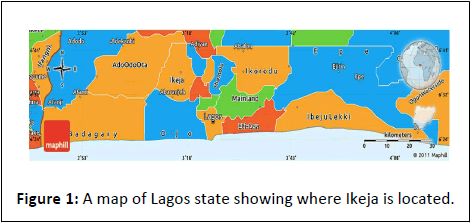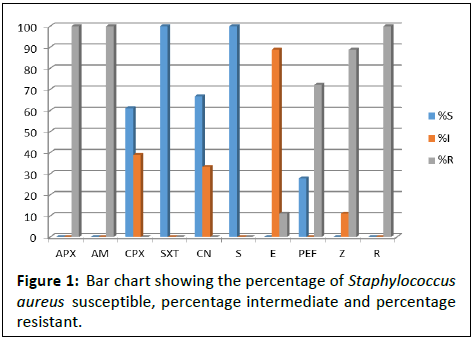ISSN : ISSN: 2576-1412
Journal of Applied Microbiology and Biochemistry
Isolation, Identification and Antibiotic Susceptibility Profile of Staphylococcus aureus Obtained from Wounds: Lagos State University Teaching Hospital, Ikeja, Lagos
Joseph Omololu-Aso1*, Rukayat Bolanle Fayinka1, Oluwaseun Oluwatoyin Omololu-Aso2, Oluwagbemiro Adesunloro1, Esther Oluwagbemisola Bello1, Alexander Adedolapo Oluyombo3, Eniola Abigail Oladimeji3, Blessing Florence Ajao4, Damilola Joseph Olaoye1, Eniola Akoledowo1, Feranmi Adebayo Ologun1, Adereti Adebobola Samuel1, Oluseun Olumuyiwa Joseph1, Akinwale Ayodeji Akinsola1, Olatujoye Funmi1 and Oki Matthew Oluwaseun1
1Department of Microbiology, Obafemi Awolo wo University, Ile-Ife, Osun State, Nigeria
2Department of Obstetrics Gyneacology, University College Hospital, Orita-mefa Ibadan, Oyo State, Nigeria
3Federal University of Technology, Abeokuta, Ogun State, Nigeria
4Department of Medicine, Benjamin Carson School of Medicine, Babcock University, Ogun State, Nigeria
- *Corresponding Author:
- Joseph Omololu-Aso
Department of Microbiology,
Obafemi Awolowo University,
Ile-Ife, Osun State,
Nigeria
Tel: 23408033770933
E-mail: omololu-aso@oauife.edu.ng
Received date: October 04, 2023, Manuscript No. IPJAMB-22-17972; Editor assigned date: October 09, 2023, PreQC No. IPJAMB-22-17972 (PQ); Reviewed date: October 24, 2023, QC No. IPJAMB-22-17972; Revised date: April 08, 2024, Manuscript No. IPJAMB-22-17972 (R); Published date: April 15, 2024, DOI: 10.36648/2576-1412.8.2.213
Citation: Omololu-Aso J, Fayinka RB, Omololu-As OO, Adesunloro O, Bello EO, et al. (2024) Isolation, Identification and Antibiotic Susceptibility Profile of Staphylococcus aureus Obtained from Wounds: Lagos State University Teaching Hospital, Ikeja, Lagos. J Appl Microbiol Biochem Vol:8 No: 2
Abstract
This study was carried out to determine the antibiotic susceptibility profile of Staphylococcus aureus isolated from wounds of patients at Lagos State University Teaching Hospital (LASUTH) Ikeja, Nigeria.
A total of 37 samples were taken from wounds at Lagos state university teaching hospital and cultured on mannitol salt agar media. The isolates were identified, using various biochemical tests, including DNase test, which confirmed the presence of Staphylococcus aureus. Antibiotic susceptibility test was carried out on the identified isolates, using the disc diffusion method.
Out of 67.5% staphylococci recovered, 48.6% of Staphylococcus aureus isolates were retrived from the 37 samples collected. The isolates were highly resistant to amoxicillin, streptomycin and ampiclox (ampicillin+cloxacillin), but susceptible to ciprofloxacin, co-trimoxazole, streptomycin, pefloxacin and gentamycin used.
Indiscriminate use of antibiotics must be avoided. Also, general hygiene practice policy should be adopted.
Keywords
Staphylococcus aureus; Infections; Antibiotic resistant; Wounds; Antibiotics
Introduction
Staphylococcus aureus has been recognised as a versatile micro-organism worldwide [1]. It may colonize the human body as a part of the normal flora. Approximately 30% of healthy people are inhabited by S. aureus, mostly in the anterior nares [2]. S. aureus is also a leading cause of Hospital Associated (HA) and Community Associated (CA) bacterial infections in humans, associating with numerous mild skin and soft tissue infections, as well as life threatening pneumonia, bacteraemia, osteomyelitis, endocarditis, sepsis and toxic shock syndrome [3]. The increasing prevalence of Methicillin Resistant S. aureus (MRSA) and its ability to resist multiple drugs has posed a serious challenge for infection control [4].
The occurrence of Staphylococcus aureus is not constant globally and its dominance in a certain region is geographically restricted [5].
In this study, we isolated, identified and carried out antibiotic susceptibility profile of Staphylococcus aureus obtained from wounds: Lagos state university teaching hospital, Ikeja, Lagos state Nigeria.
Materials and Methods
Ikeja is a local government area in Lagos state, with headquarters in Ikeja. Ikeja local government area covers an area of 49.9 km2. It is bounded to the north by Ogun state, to the East by Kosefe local government areas, and to the West by Alimosho, Agege and Ifako-Ijaiye local government areas (Figure 1).

Figure 1: A map of Lagos state showing where Ikeja is located.
Sample collection
Sterile swab sticks moistened with 0.8% sterile normal saline were used to collect a total of 37 samples from wounds of patients, at Lagos State University Teaching Hospital (LASUTH). This was done with the aid of a medical practitioner, and was immediately transferred to the bacteriological laboratory, microbiology department, Obafemi Awolowo University. They were further transferred into nutrient broth so as to avoid streamlining of organisms and to increase growth and metabolism of organisms.
Isolation, identification and characterization
A loop full from turbid nutrient broth containing the sample was streaked out on nutrient agar until pure colonies were isolated and then sub cultured on Manitol Salt Agar (MSA). Gram staining, microscopy, morphological identification, catalase test, coagulase test, DNase teat, oxidase test, sugar fermentation analysis and antimicrobial susceptibility trends of the isolate were conducted.
Results
A total sum of 25 (67.5%) Staphylococcal isolates were recovered from 37 samples collected and 18 (48.6%) were confirmed as Staphylococcus aureus (Tables 1 and 2, Figure 2).
| Serial number | Sample and isolates recovered | Male | Female |
|---|---|---|---|
| 1 | Number of sample taken | 17 | 20 |
| 2 | Number of Staphylococci recovered | 10 | 15 |
| 3 | % composition of Staphylococci recovered | 40% | 60% |
| 4 | Number of S. aureus isolates recovered | 7 | 11 |
| 5 | % composition of S. aureus isolates | 38.90% | 61.10% |
Table 1: Shows the percentage composition of Staphylococci and Staphylococcus aureus isolates in both genders.
| Antibiotics | N | Ns | %S | Ni | %I | Nr | %R |
|---|---|---|---|---|---|---|---|
| APX | 18 | 0 | 0 | 0 | 0 | 18 | 100 |
| AM | 18 | 0 | 0 | 0 | 0 | 18 | 100 |
| CPX | 18 | 11 | 61.1 | 7 | 38.9 | 0 | 0 |
| SXT | 18 | 18 | 100 | 0 | 0 | 0 | 0 |
| CN | 18 | 12 | 66.7 | 6 | 33.3 | 0 | 0 |
| S | 18 | 18 | 100 | 0 | 0 | 0 | 0 |
| E | 18 | 0 | 0 | 16 | 88.9 | 2 | 11.1 |
| PEF | 18 | 5 | 27.8 | 0 | 0 | 13 | 72.2 |
| Z | 18 | 0 | 0 | 2 | 11.1 | 16 | 88.9 |
| R | 18 | 0 | 0 | 0 | 0 | 18 | 100 |
| Key: N: Number of isolates; Ns: Number of susceptible isolates; Ni: Number of intermediate isolates; Nr: Number of resistant isolates. | |||||||
Table 2: Shows the antibiotic susceptibility of Staphylococcus aureus isolates from both male and female sources.
Figure 2: Bar chart showing the percentage of Staphylococcus aureus susceptible, percentage intermediate and percentage resistant.
Note: %S: Percentage Susceptible; %I: Percentage Intermediate; %R: Percentage Resistance; APX: Ampiclox (Ampicillin+Cloxacillin); AM: Amoxicillin; CPX: Ciprofloxacin; SXT: Co-trimoxazole; CN: Gentamicin; S: Streptomycin; E: Erythromycin; PEF: Pefloxacin; Z: Cefuroxime; R: Ceftriaxone
Discussion
From the results, 18 (48.6%) Staphylocccus aureus were isolated from wounds. This correlates with the result obtained from the department of pharmaceutics and pharmaceutical microbiology, Usmanu Danfodiyo university, Sokoto Nigeria [6]. Also from the antibiotic susceptibility test result, Staphyloccocus aureus showed 100% resistance to ampiclox (ampicillin +cloxacillin), 100% resistance to amoxicillin, 11.1% resistance to erythromycin, 72.2% resistance to pefloxacin, 88.9% resistance to cefuroxime, 100% resistance to ceftriaxone, 0% resistance to ciprofloxacin, co-trimoxazole, streptomycin and gentamicin. This shows that S. aureus has developed a high resistance to ampiclox (ampicillin+cloxacillin), amoxicillin, ceftriaxone. The striking development of the resistance to ampiclox (ampicillin+ cloxacillin), amoxicillin and ceftriaxone antibiotics may be related to the drug therapy the patients have been on at the hospital. Also 100% susceptibility to co-trimoxazole shows that the patients might not have been given the antibiotic yet, at the hospital. From the biochemical test result, out of 25 staphylococcal isolates, 18 were confirmed S. aureus, with DNase agar.
From the analysis of the presence of Staphylococcus aureus in both male and female, it was seen that the percentage of the presence of Staphylococcus aureus in males was much lower than that of the females. While the males had 38.9%, the females had 61.1%. It can be inferred that the occurrence of Staphylococcus aureus in wound infections is more prevalent in females than in males. This correlates with the result obtained from the department of Pharmaceutics and Pharmaceutical Microbiology, Usmanu Danfodiyo University, Sokoto-Nigeria.
Conclusion
This study indicated that female individuals are more vulnerable to Staphylococcal infection in the study area, and that co-trimoxazole is the most potent antibiotic to wound infections.
Proper hygiene practice standard procedures should be encouraged among health care workers to prevent possible dissemination of Staphylococcus aureus in their facilities.
References
- David MZ, Daum RS (2010) Community-associated methicillin-resistant Staphylococcus aureus: Epidemiology and clinical consequences of an emerging epidemic. Clin Microbiol Rev 23:616-687
[Crossref] [Google Scholar] [PubMed]
- Junie LM, Simon LM, Pandrea SL (2014) Resistance to the chemotherapeutic agents of Staphylococcus aureus strains isolated from hospitalized patients. Int J Infect Dis 21:79-80
- Tokajian S (2014) New epidemiology of Staphylococcus aureus infections in the Middle East. Clin Microbiol Infect 20:624-628
[Crossref] [Google Scholar] [PubMed]
- David MZ, Boyle-Vavra S, Zychowski DL, Daum RS (2011) Methicillin-susceptible Staphylococcus aureus as a predominantly healthcare-associated pathogen: A possible reversal of roles. PLoS One 6:e18217
[Crossref] [Google Scholar] [PubMed]
- Olowo-Okere A, Ibrahim YK, Sani AS, Atata RF, Olayinka BO (2017) Prevalence of surgical site infection in a Nigerian university teaching hospital. J Pharm Allied Sci 14:2430-2438
- Rasigade JP, Dumitrescu O, Lina G (2014) New epidemiology of Staphylococcus aureus infections. Clin Microbiol Infect 20:587-588
[Crossref] [Google Scholar] [PubMed]
Open Access Journals
- Aquaculture & Veterinary Science
- Chemistry & Chemical Sciences
- Clinical Sciences
- Engineering
- General Science
- Genetics & Molecular Biology
- Health Care & Nursing
- Immunology & Microbiology
- Materials Science
- Mathematics & Physics
- Medical Sciences
- Neurology & Psychiatry
- Oncology & Cancer Science
- Pharmaceutical Sciences

